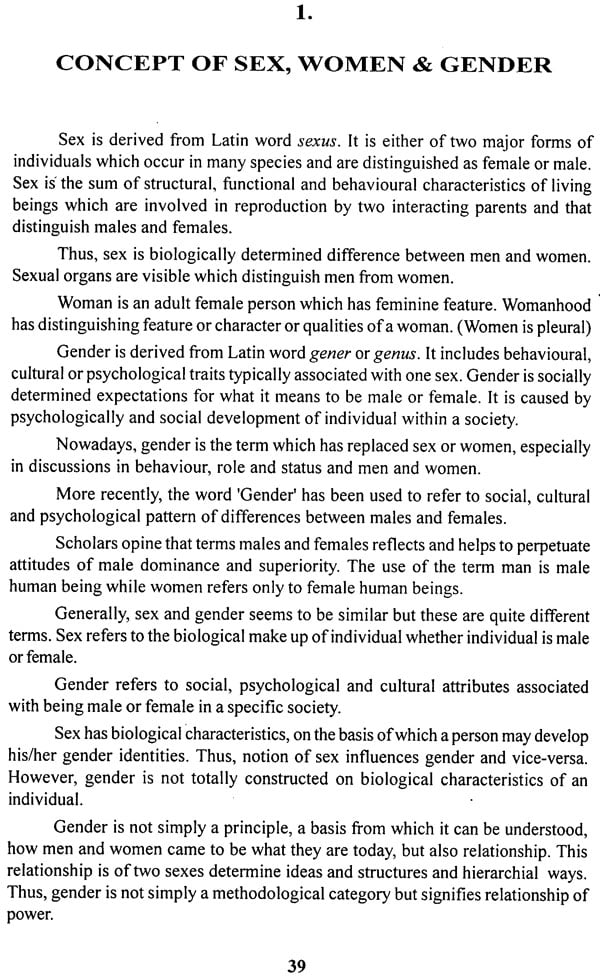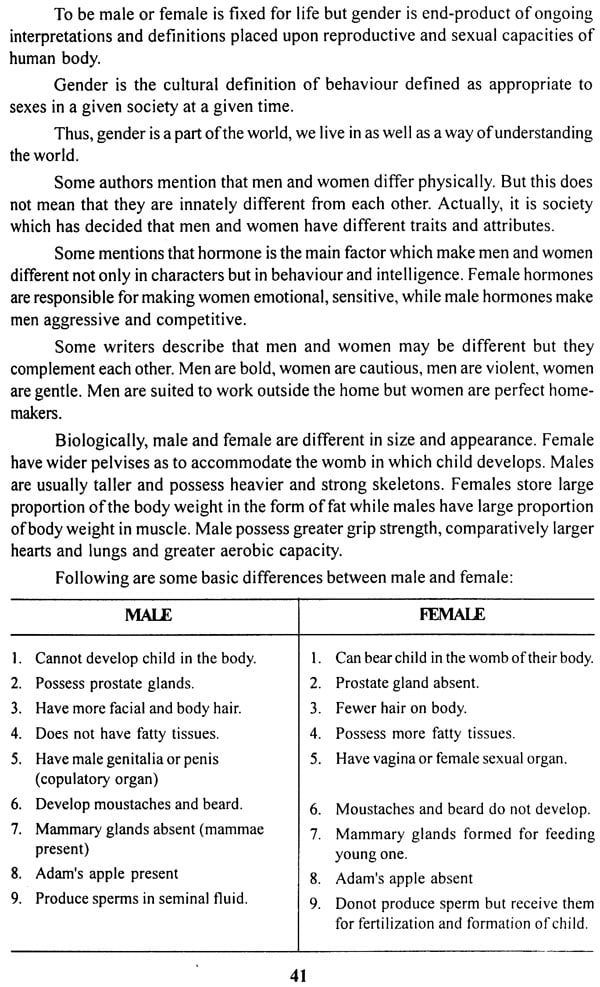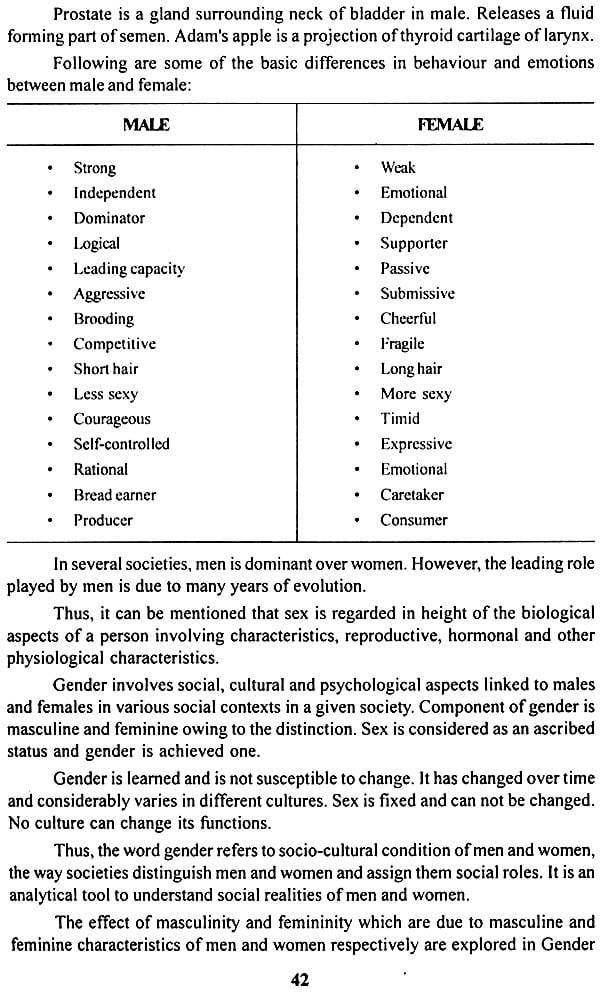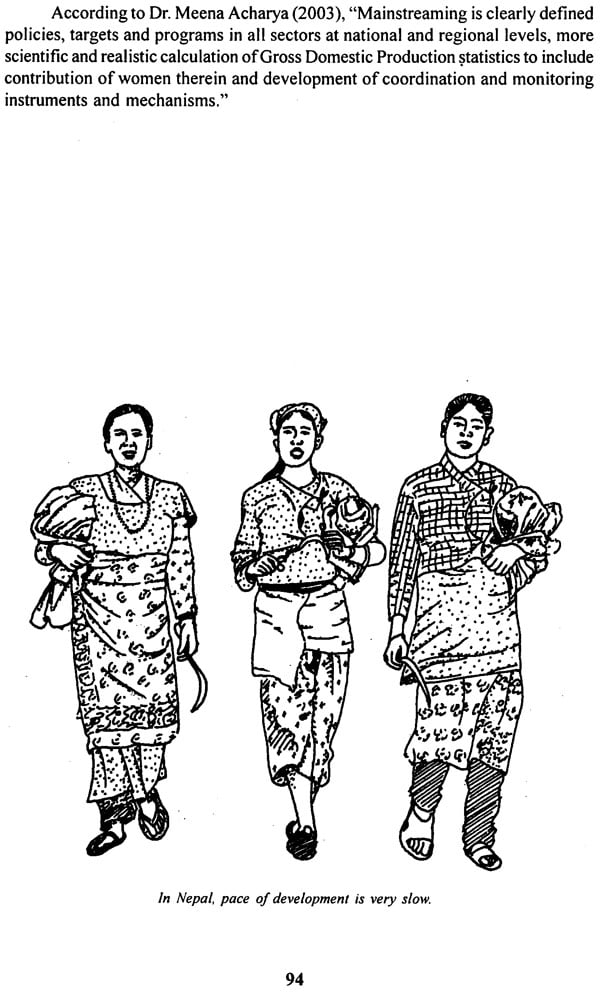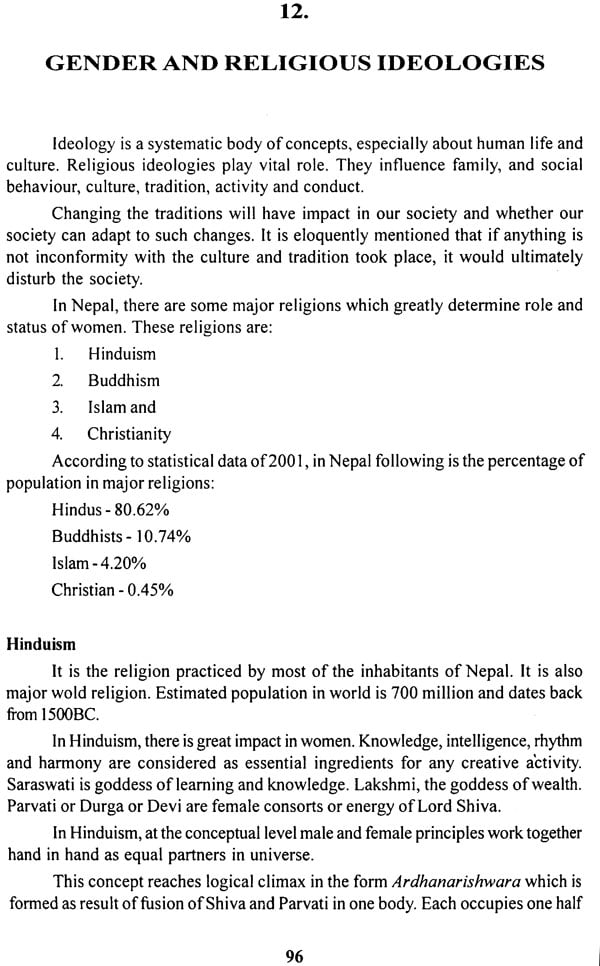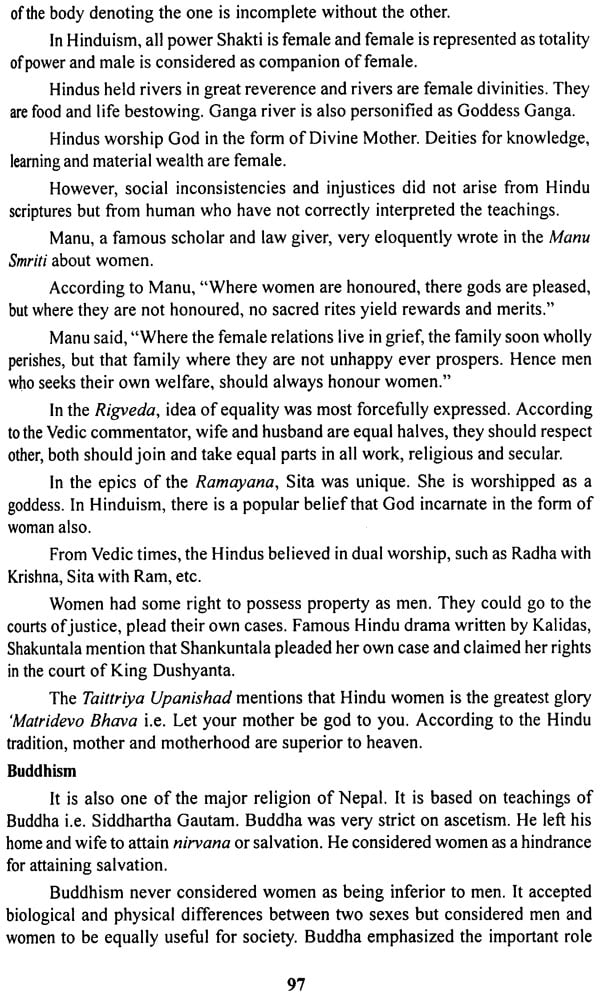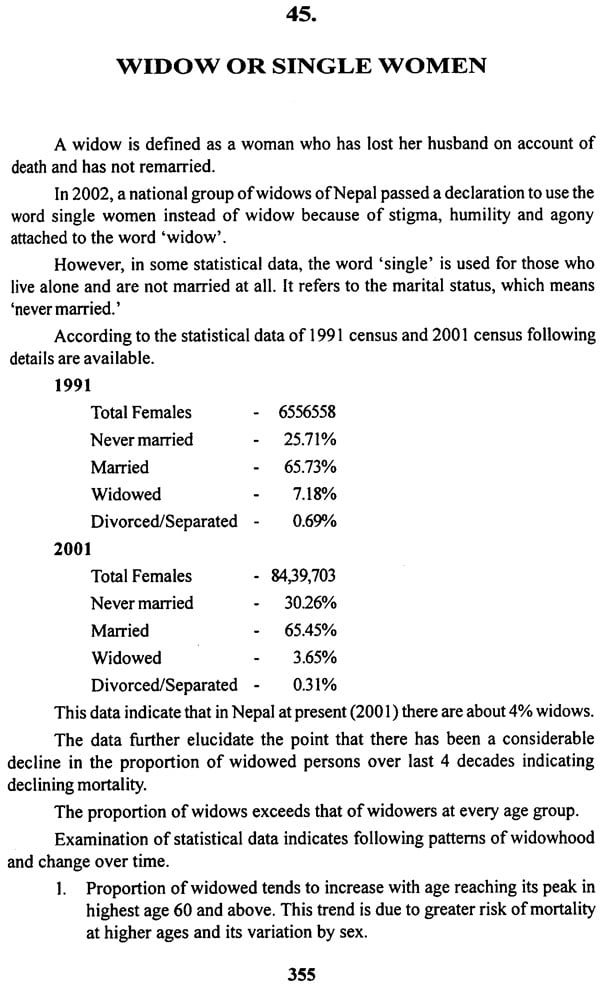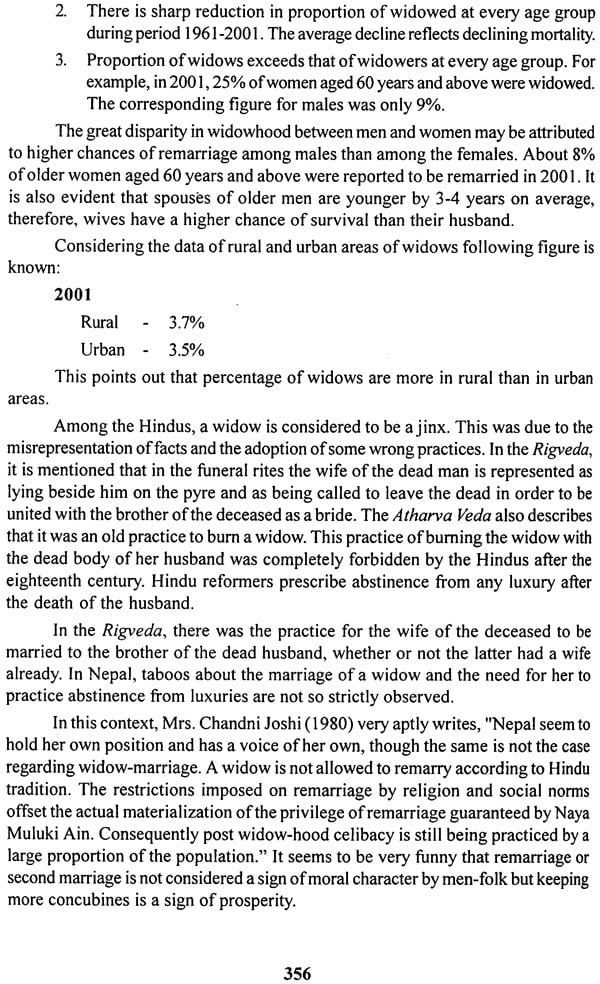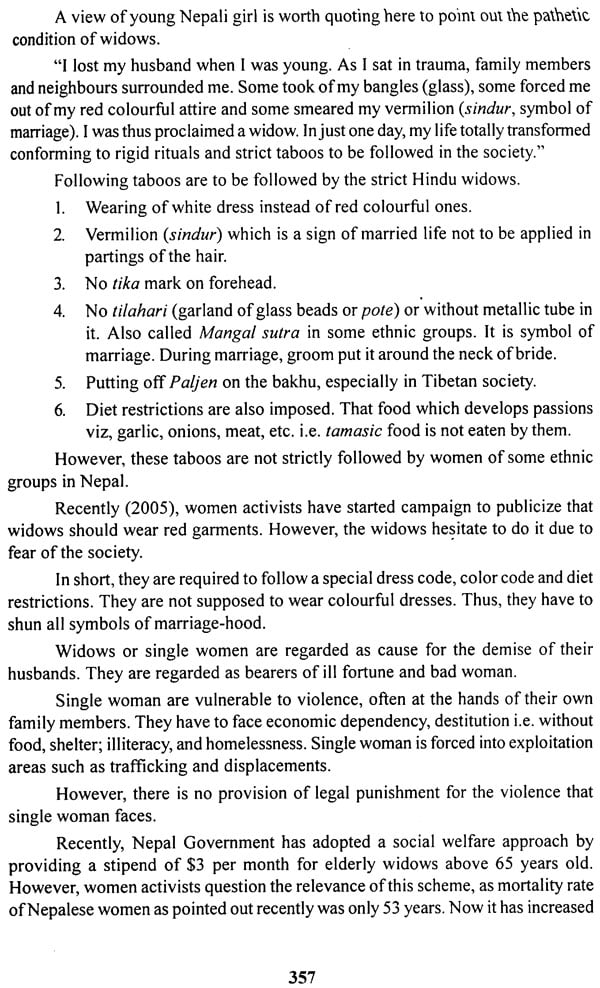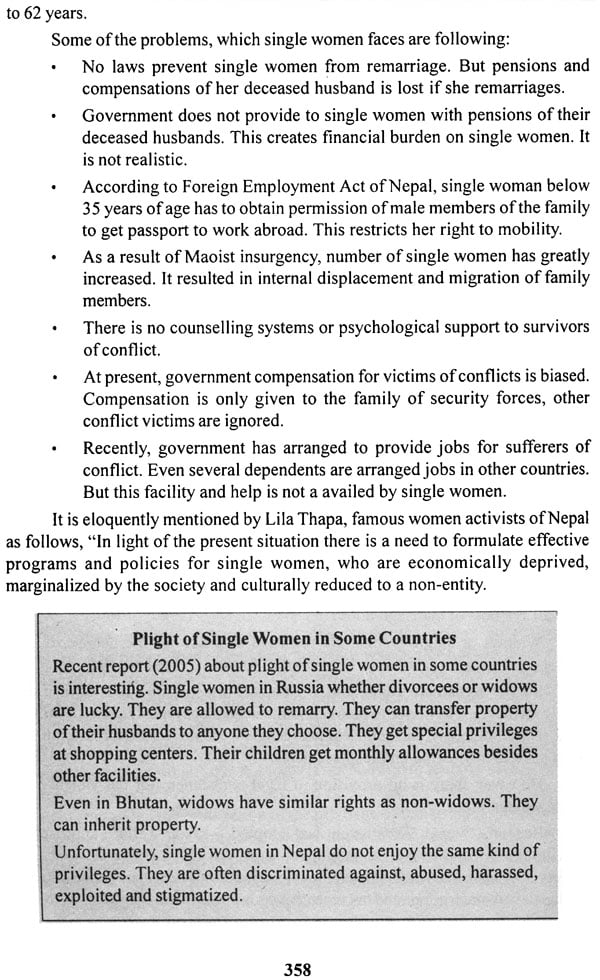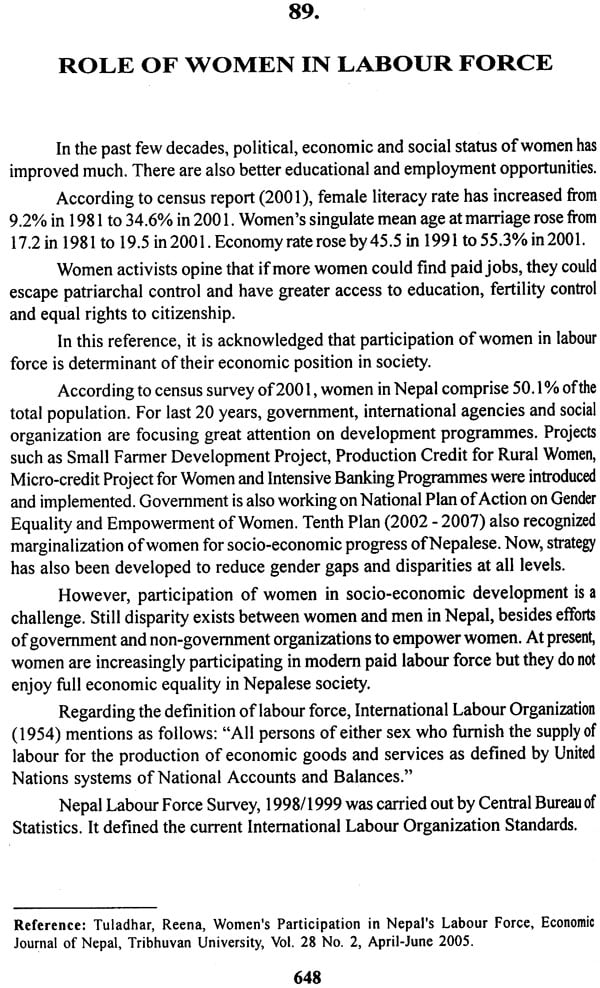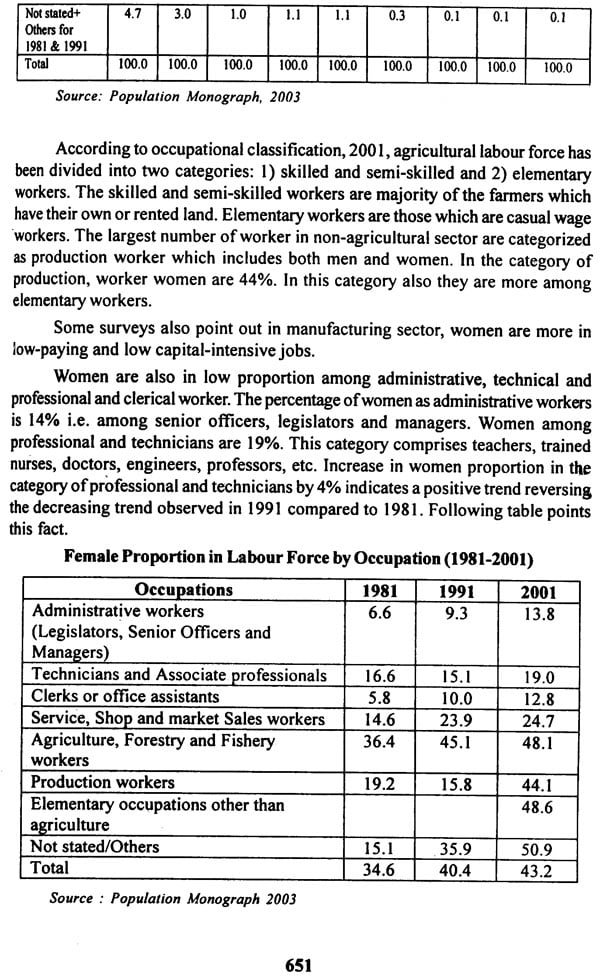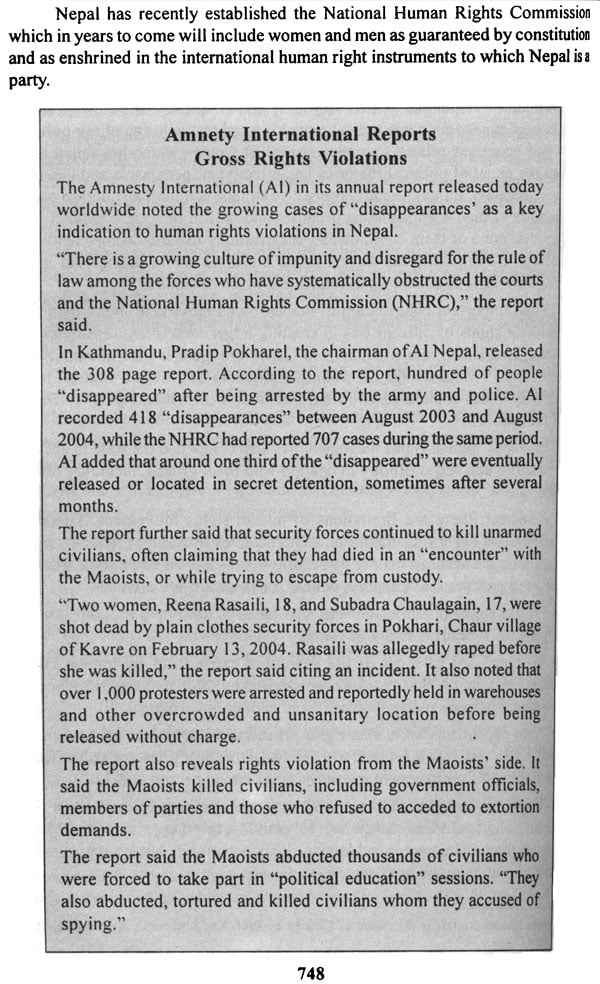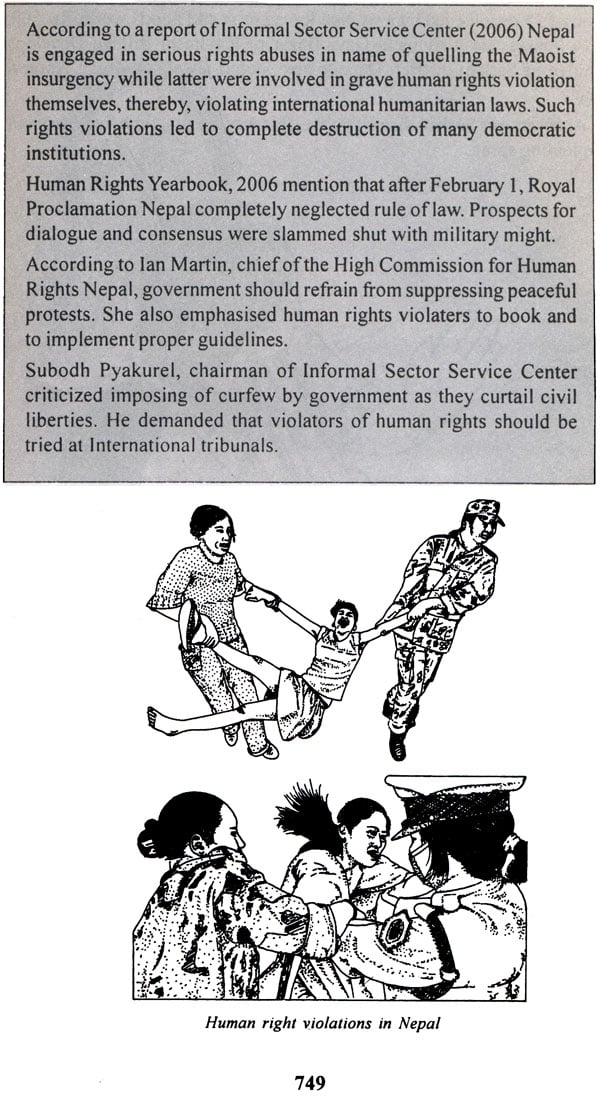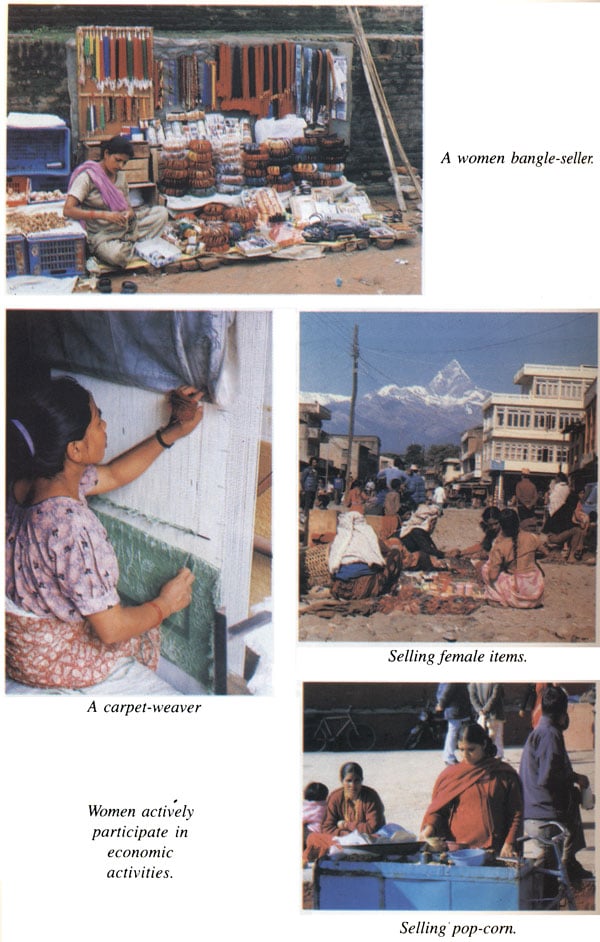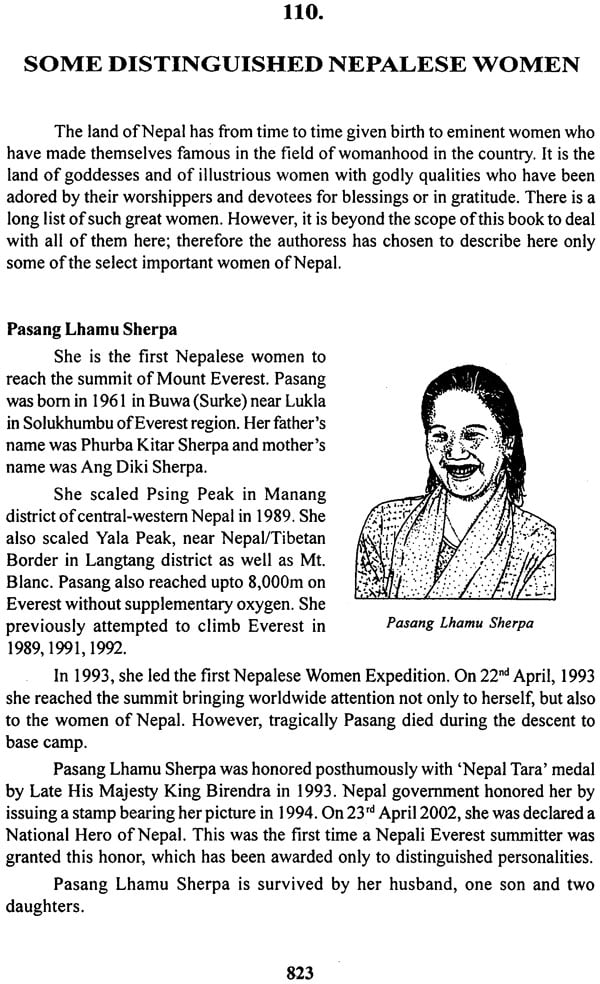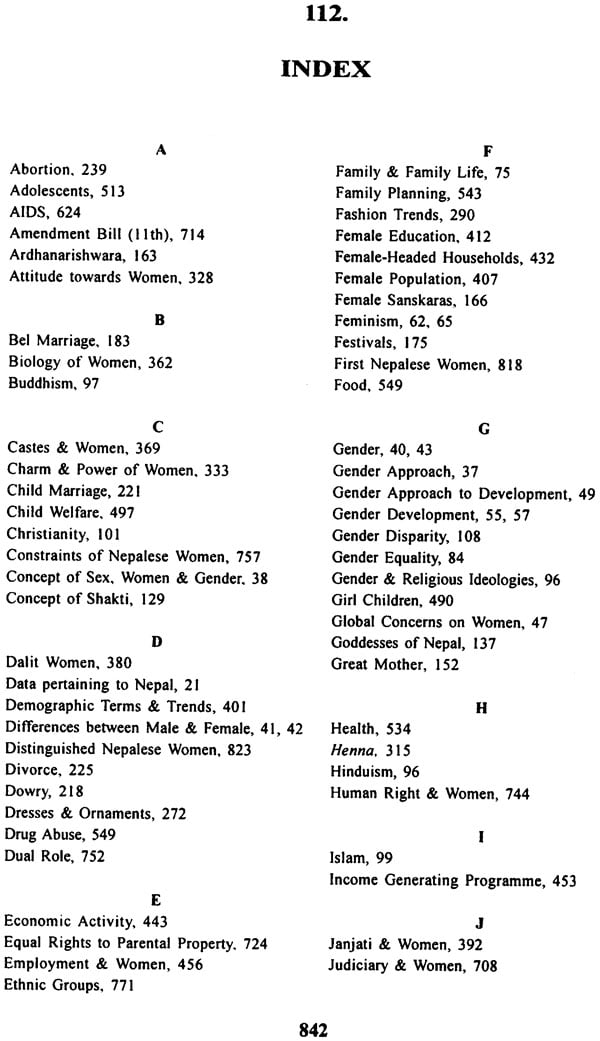
Nepalese Women (A Vivid Account of the Status and Role of Nepalese Women in the Total Spectrum of Life, Religious, Social, Economic, Political, and Legal)
Book Specification
| Item Code: | NAM291 |
| Author: | Indra Majupuria |
| Publisher: | Indra Majupuria, Nepal |
| Language: | English |
| Edition: | 2007 |
| ISBN: | 9789748967561 |
| Pages: | 844 (Throughout Color and B/W Illustrations) |
| Cover: | Paperback |
| Other Details | 8.5 inch X 6.0 inch |
| Weight | 1.10 kg |
Book Description
Women constitute more than half of the population in Nepal and the female population of Nepal is among the highest in Asia. In Hinduism and Buddhism, the status and role of women are not only high but also very respectful. She is credited with this rank because 'Self' found no delight without her. The very story of creation among the Hindus mentions that she was born within herself as a part which should remain in union with other half. This concept of union of the two magnetic opposites, i.e. male and female principles. The complimentary forces are regarded as positive and negative charges. Without the female partner, the bliss of being one and state of beautitude in union can not be obtained.
In Hinduism love and romance also began with the union of the primary couple Yama and Yami who were the first progenitors of the human race. The Rigveda also testified to the fact that Yama and Yami were the offspring of heavenly Gandharvas (celestial musicians) or were created by Brahma. As there was nobody else to perpetuate the race, Yami earnestly requested Yama to become her husband.
It is also described that four ideals i.e.kama (pleasure), dharma (religion), artha (wealth) and moksha (salvation) can be achieved by every person and for attaining them it is obligatory for a man to have the company of woman. Women have also been brought to bear in various practices of Yoga and Tantric rites. Love has its origin only in the association of a woman. Poets and scholars have gloriously described the ineffable sentiments of lovers and the enchanting beauty of a woman, her youth and her artistic body. The female force is strong and important as it provides a base for creating force and forms an organic component of cosmic concept of living.
The concept of supreme divinity lies in the woman, the mother and the womb. The Tantras also advocate that Kameshwara, the lord of sex should be worshipped seated with her consort. The Tantras also describe that the main companion of attraction (Krishna) is success (Radha), his childhood companion. Radha is symbolically success or achievement. According to the Saktisangama Tantra, “A woman is the creator of the universe and the universe is her form. A woman is the foundation of the world. She is the true form of the body. A woman is the supreme form of all things. There is no jewel rarer than a woman. There have never been nor will there ever be a destiny equal to that of a woman. There is no kingdom or destination to be compared with a woman."
In Nepal, females are worshipped as living goddesses. There are hosts of goddesses both in Hinduism, Buddhism and Tantrism that are worshipped by Nepalese. This view is so much emphasized in this country that the law prohibits even the sacrifice of female animals.
In Nepal, women are regarded as earthly manifestations of Kali, the Queen of Gods and Goddesses. The Agama Tantra favours both sexes equally and makes no distinction between men and women, or even between respectable women and prostitutes as all women are made equal.
Tantrics hold women in great esteem and call them Shakti, the power and to ill-treat Shakti or women is considered to be a cardinal sin. This is also the version of epics.
Thus, culturally the picture of women in Nepal is quite favourable. However, the socio-economic status of women is also to be considered which counteracts the cultural background there is.
No doubt the socio-economic condition in the medieval period of Nepal was very bad. Conditions have greatly improved in modem Nepal. However, literacy rate among women (2001) was 42.8% while in male it was 65.5% as against the average 54.1 %.
Considering some parameters pertaining to Nepalese women, mortality rate was about 41 years while national average mortality rate was 45.5 years. Infant mortality rate estimated in 2004 was 64.4 per 1000 live births.
Life expectancy for female is 62.50 years while for male it is 61.76 years while average life expectancy at birth is 62.20 years. Total fertility rate of children per women of 15-49 years age is 4.1.
Statistic data shows that women are subject to both unemployment and underemployment. Majority of the women are self-employed. Total unemployment rate in female is 9.2% while in male is 7.0% while total employment rate is 8.1 %.
Economically, women are weak and subjected to low paying and unskilled job. Economically active aged 10 and above male are 71.7% while females are 43.4%.
Household work i.e. rearing of children is not recognized as any significant job socially and economically.
The condition of rural women in Nepal is very pathetic. In rural areas child marriages are still prevalent. The percentage of literacy among women in rural areas is almost negligible. The population growth results in the hazards of health of the mother and the child. Women are considered inferior to men in various ethnic groups. The condition as a whole of rural women is more critical than their counterparts in the urban society where there is more consciousness among women as regards their social and legal rights. However, in urban Nepalese women also there is a big gap between the status they enjoy in theory and in practice. Social attitudes, restrictions on mobility and lack of independent status are quite evident in urban women also.
It has now been fully realized that the lower status of women hampers the growth of human beings. The status of Nepali women is legally strong but institutionally weak. However, in the present day challenges, equal participation of both men and women is absolutely essential and its importance is being gradually realised by more and more people in the country.
In this context, it is high time for institutional reforms in the status of women for all-round development. It requires changes over traditional attitudes.
For economic development, it is essential to entail the removal of wage discrimination, creation of new employment opportunities, acceptance of women's right to property, rights over children, alimony, divorce rules, recognition of household jobs as direct contributions to economy. Besides the general development of women, their health, nutrition, fertility and life expectancy are other factors to be looked into.
History also has played an important role in the status of women in Nepal. During the Rana regime the status of women was lower than that of men, both in family and society. However, the new set up was very much in favour of women. The social and economic position of women was greatly augmented by various plans and programmes, institution and social reforms. This is also responsible for uplifting the status of women in Nepal even by means of reforms in the constitution through the promulgation of favourable civil codes. Modern eves of Nepal are in a better position in all fields either social or economic. They are well-placed owing to various legal and social measures adopted a few decades ago. Still owing to the lack of proper education, knowledge, and ignorance the condition has not improved to that extent. Visualising the national development plans, in all the development plans there is no specific allusion for women. As already said, the condition of rural women is still very much as it was earlier.
After being state party to Convention on Elimination of All Forms of Discrimination enforced on September 3, 1981, sufficient efforts have been introduced to protect and promote women's human rights. Nepalese socio-cultural beliefs, rural poverty, traditional barrier, lack of resources and realization of women's rights are major constraints in implementing the provisions to enhance status of women and secure women's human right.
However, there is need of efforts to eliminate all forms of discrimination against women either created by societies, tradition and beliefs or statutory law and administrative policies to empower woman and brought them into mainstream of development.
Thus, the purpose of this book is to present to the readers cultural, economic and social condition of both rural and urban women in the Nepalese society and the need for new norms and reforms to change the status of women for participation in decision making programme and all-round development not only in the country but in all activities concerning the human race.
In Nepal, there is a great scope for studies about women, especially the village women of various ethnic groups, and their socio-economic conditions. There is not much literature about the women of Nepal. Almost no book has been written covering various aspects of the role of women in development. However, cultural background which is very important for the status and role of women, is completely ignored. The authoress earlier studied one aspect of women and has published a book on 'Marriage Customs of Nepal'. Now there is growing awareness of the needs and welfare of the women among everyone including the planners and reformers. The decision to observe the women's decade is a proof of it.
Some small booklets and articles have been published on the women of Nepal. A few ambitious research projects on the Nepalese women are also undertaken. Any addition to them seems to be rather superflous. However, my justification for writing this book is twofold. Firstly, the articles are scattered in various journals and several of them are in Nepali language. Secondly, small booklets and research projects deal only with one or two particular aspects of women and other equally important aspects are ignored. Therefore, the authoress studied different spectra of life of Nepalese women - the religious, economic, political, legal, social points of view. This venture is not only the result of her assiduous study but also research on women, especially in the present perspective. Considering the present scenario of Nepal, several new chapters have been added in this book and others are deleted. Unfortunately, in Nepal, women are ignored to such an extent that not a single book is published on this title while in other countries more than hundred of books are published and still there is scope and market for more such books. Thus, this book is an humble beginning to introduce to the readers the past, present and future of Nepalese women.
Indra Majupuria. M.A. (Economics and Sociology), B. Ed. is a sociologist and psychologist. She has been teaching for about 28 years at various levels including 7 years as lecturer in the' Institute of Education, Kirtipur Campus, Tribhuvan University. She has written several books as a co-author with Prof. Dr. T.C. Majupuria, D.Sc., having teaching and research experience of 55 years including 40 years in Nepal. Her outstanding publications are: Nepalese Youth, Joys of Nepalese Cooking, Tibetan Cooking, the Complete Gudie to Nepal, Pashupatinath, Erotic Themes of Nepal. Her main interests are in the social, cultural and educational fields. She has worked on various projects and has written a number of articles for popular audience. Some of her books have been translated in Japanese, Thai, German, Italian languages. The book on Kumari has been used for script for some films in English, Japanese and German languages. Indra has travelled in several countries viz., Kuwait, Thailand, Japan, Hong Kong, U.K., U.S.A., Canada, Singapore, Malaysia, India, etc.
| A | About this edition | 9 |
| B. | Why this book? | 13 |
| C. | Some Data Pertaining to Women | 21 |
| Part I | Gender Approach | 37 |
| 1 | Concept of Sex, Women, and Gender | 38 |
| 2 | Global & Nepalese Concerns on Women | 46 |
| 3 | Gender Approach to Development | 49 |
| 4 | Comparison of Women in Development (WID), Women and Development (WAD) and Gender and Development (GAD) Approaches | 54 |
| 5 | Feminism | 61 |
| 6 | Patriarchy | 67 |
| 7 | Matriarchy | 72 |
| 8 | Family and Family Life | 74 |
| 9 | Gender Equality | 83 |
| 10 | Kinship and Gender | 90 |
| 11 | Mainstreaming of Women | 92 |
| 12 | Gender and Religious Ideologies | 95 |
| 13 | Gender Disparity | 107 |
| 14 | Subordination of Women | 115 |
| Part II | Religious and Cultural Approach | 117 |
| 15 | Virgin Goddess Kumari and Her Worship | 118 |
| 16 | Concept of Shakti or Female Power | 128 |
| 17 | Goddess of Nepal | 136 |
| 18 | The Great Mother | 151 |
| 19 | Panchakanyas | 156 |
| 20 | Ardhanarishwara | 162 |
| 21 | Female Samskaras (Life cycle rituals) | 166 |
| 22 | Traditional Festivals Observed by Women | 174 |
| 23 | Bel Marriage (Ihi) | 182 |
| 24 | Institution of Marriage | 197 |
| 25 | Marriage and Conjugal Relations | 198 |
| 26 | Types of Marriage | 205 |
| 26 | a. Polygamy | 214 |
| 27 | Dowry | 217 |
| 28 | Child Marriage | 220 |
| 29 | Divorce | 224 |
| 30 | Rape | 228 |
| 31 | Suicide in Women | 234 |
| 32 | Abortion | 238 |
| 33 | Sati Custom | 245 |
| 34 | Prostitution | 256 |
| 35 | Purdah System | 260 |
| 36 | Songs and Dances of Women | 265 |
| 37 | Dresses and Ornaments | 271 |
| 37 | a. Why Red Colour Popular in Nepal? | 285 |
| 38 | Fashion Trends in Girls | 289 |
| 39 | Tattooing | 311 |
| a. | Henna or Mehandi | 314 |
| b. | Upbringing of a girl | 320 |
| 40 | Attitude Towards Women | 327 |
| 41 | Charm and Power of Women | 332 |
| 42 | Status of Women in Ancient and Medieval Periods | 338 |
| 43 | Social Status | 342 |
| 44 | Relation between Husband and Wife | 348 |
| 45 | Widow or Single Women | 354 |
| 46 | Biology of Women | 361 |
| 47 | Castes and Women | 368 |
| 48 | Dalit Women | 379 |
| 49 | Janjati and Women | 391 |
| Part III | Social, Economic, Political and Legal Approaches | 398 |
| 50 | Some Demographic Terms and Trends | 400 |
| 51 | Nepali Women - The Poorest of the Poor | 402 |
| 52 | Female Population | 406 |
| 53 | Female Education | 410 |
| 54 | Literacy in Women | 423 |
| 55 | Female-headed Household | 431 |
| 56 | Women's Property | 438 |
| 57 | Economic Activity | 442 |
| 58 | Occupation | 446 |
| 59 | Income Generating Programmes for Women | 452 |
| 60 | Employment and Women | 455 |
| 61 | Un-Employment and Women | 460 |
| 62 | Women in Urban Milieu | 465 |
| 63 | Women in Rural Development | 480 |
| 64 | An Overview of Situation of Girl Children | 489 |
| 65 | Children and Child Welfare | 496 |
| 66 | Children and Women | 504 |
| 67 | Adolescents and Youth Women | 512 |
| 68 | Status of Elderly Women | 517 |
| 69 | Marital Status and Women (Nuptiality) | 527 |
| 70 | Women and Health | 533 |
| 71 | Family Planning | 542 |
| 72 | Food, Tea, Smoking, Drug Abuse and Alcoholism | 548 |
| 73 | Drinking Water and Sanitation Facilities and Women | 561 |
| 74 | Role of Women in Irrigation | 564 |
| 75 | Role in Agriculture | 569 |
| 76 | Women and Forests | 575 |
| 77 | Role of Women in Livestock Farming | 580 |
| 78 | Women and Environment | 584 |
| 79 | Tourism and Women | 590 |
| 80 | Women in Media | 596 |
| 81 | Women in Government Administration | 603 |
| 82 | Migration in Women | 608 |
| 83 | Trafficking of Women | 611 |
| 84 | Women and Sexually Transmitted Diseases | 620 |
| 85 | Women and AIDS | 623 |
| 86 | Microfinance: A Powerful Paradigm for Women | 631 |
| 87 | Role of Women in Trade Union | 639 |
| 88 | Role of Women in Informal Sector | 642 |
| 89 | Role of Women in Labour Force | 647 |
| 90 | Empowerment of Women | 657 |
| 91 | Women and Politics | 667 |
| 92 | Women in Development and Planning | 681 |
| 93 | Sustainable Development and Women | 689 |
| 94 | Legal Status of Women | 694 |
| 95 | Judiciary and Women | 707 |
| 96 | Major Reform by 11th Amendment Bill | 713 |
| 97 | Women Under International Law | 716 |
| 98 | Equal Rights to Parental Property | 723 |
| 99 | Violence Against Women | 726 |
| 100 | Maoist Insurgency and Women | 737 |
| 101 | Human Rights and Women | 743 |
| 102 | Dual Role | 751 |
| 103 | Overall Features and Constraints of Nepalese Women | 756 |
| 104 | Outlook of Modern Nepalese Women | 762 |
| 105 | Women in Ethnic Groups | 770 |
| 106 | Women's Organization (Political, Social and Governmental) | 788 |
| 107 | Non-Government and International Non-Governmental Sectors for Women's Promotion | 799 |
| 108 | Role of Women in Revival of Democracy (2006) | 810 |
| 109 | Some First Nepalese Women | 817 |
| 110 | Some Distinguished Nepali Women | 822 |
| 111 | Select References | 834 |
| 112 | Index | 841 |
| About the Authoress | 844 |
